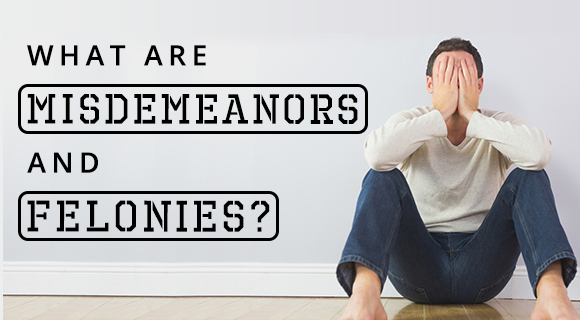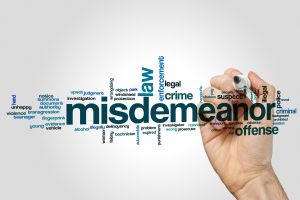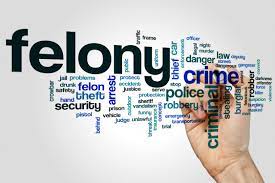
FELONY IS (NOT) A FRIEND FOR LIFE … BUT IT STAYS WITH YOU FOR LIFE!
Criminal charges are divided into two primary classifications: misdemeanors and felonies. This single difference can have a significant impact on your life if you are convicted. In the most general sense, misdemeanors aren’t as serious as felonies. The penalties for misdemeanors are usually less serious than those for a felony.
 What Are Misdemeanors?
What Are Misdemeanors?
While particular laws vary by state, misdemeanors generally include nonviolent crimes. In many cases, misdemeanors do not lead to long amounts of jail time, almost always one year or less. Misdemeanors can include vandalism, certain types of drug possession, simple assault, and disorderly conduct, among others.
Wisconsin’s Misdemeanor classifications include Class A Misdemeanor, Class B Misdemeanor and Class U Misdemeanor.
Class A Misdemeanor
The maximum penalty for a Class A Misdemeanor includes a fine up to $10,000, or imprisonment for up to 9 months, or both; however, for a repeat offender charged with a penalty enhancer, the term of imprisonment may increase up to 2 years. Note that multiple Misdemeanor charges may result in multiple convictions that, if run consecutively, may exceed one year.
Class B Misdemeanor
The maximum penalty for a Class B Misdemeanor includes a fine up to $1,000, or imprisonment for up to 90 days, or both; however, for a repeat offender, the term of imprisonment increase up to 2 years. As well, multiple Misdemeanor charges may result in multiple convictions that, if run consecutively, may exceed one year.
Class U Misdemeanor (unclassified)
These vary dpednign on the crime. Some unclassified misdemeanors can be up to one year in jail while other are limited to 30 days.
 What Are Felonies?
What Are Felonies?
Crimes that are classified as felonies tend to involve physical violence, or some type of action that can cause extreme harm psychologically. Examples of felony crimes include manslaughter or murder, aggravated assault, kidnapping, and more. Felonies can also involve nonviolent activities that are still considered extremely harmful. These types of felonies can include grand theft, tax evasion, perjury, copyright infringement, and parole or probation violations. Generally felonies involve penalties in excess of one year incarceration.
Wisconsin classifies its Felony crimes (and Misdemeanor crimes) according to the sentence allowable under the Statute. Felony classes include Class A Felony, Class B Felony, Class C Felony, Class D Felony, Class E Felony, Class F Felony, Class G Felony, Class H Felony and Class I Felony.
CLASS A FELONY
For a Class A Felony, the penalty is imprisonment for life.
Examples of Class A Felony crimes are First Degree Homicide.
CLASS B FELONY
For a Class B Felony, the penalty is imprisonment up to 60 years; however, for a repeat offender the term of imprisonment may increase up to 2 years with prior misdemeanor convictions, and up to 6 years with a prior Felony conviction.
Examples of Class B Felony crimes are Second Degree Homicide, First Degree Reckless Homicide, Conspiracy, Kidnapping.
CLASS C FELONY
For a Class C Felony, the penalty is a fine of up to $100,000, or imprisonment of up to 40 years, or both; however, for a repeat offender, the term of imprisonment may increase by up to 2 years with prior misdemeanor convictions, and by up to 6 years with a prior Felony conviction.
Examples of Class C Felony crimes are Second Degree Sexual Assault, Kidnapping, or Armed Robbery.
CLASS D FELONY
For a Class D Felony, the penalty is a fine of up to $100,000, or imprisonment of up to 25 years, or both; however, for a repeat offender, the term of imprisonment may increase by up to 2 years with prior misdemeanor convictions, and increase by up to 6 years with a prior Felony conviction.
Examples of Class D Felony crimes are Felony Drunk Driving, Felony Vehicular Homicide, Vehicular Homicide While Intoxicated, or First Degree Reckless Injury.
CLASS E FELONY
For a Class E Felony, the penalty is a fine of up to $50,000, or imprisonment of up to 15 years, or both; however, for a repeat offender, the term of imprisonment may increase up to 2 years with prior misdemeanor convictions, and up to 6 years with a prior Felony conviction.
Examples of Class E Felony crimes are Battery with Great Bodily Harm, Burglary, or Robbery.
CLASS F FELONY
For a Class F Felony, the penalty is a fine of up to $25,000, or imprisonment of up to 12-1/2 years, or both; however, for a repeat offender, the term of imprisonment may increase by up to 2 years with prior misdemeanor convictions, and by up to 6 years with a prior Felony conviction.
Examples of Class F Felony crimes are Burglary, Stalking, Theft, or Second-degree Reckless Injury.
CLASS G FELONY
For a Class G Felony, the penalty is a fine of up to $25,000, or imprisonment of up to 10 years, or both; however, for a repeat offender, the term of imprisonment may increase by up to 2 years with prior Misdemeanor convictions, and by up to 6 years with a prior Felony conviction.
Examples of Class G Felony crimes are Negligent Homicide, Negligent Vehicular Homicide, Embezzlement, Theft, or Felon In Possession Of Firearm.
CLASS H FELONY
For a Class H Felony, the penalty is a fine of up to $10,000, or imprisonment of up to 6 years, or both; however, for a repeat offender, the term of imprisonment may increase by up to 2 years with prior misdemeanor convictions, and by up to 6 years with a prior Felony conviction.
Examples of Class H Felony crimes are Battery with Great Bodily Harm, False Imprisonment, talking, and Theft (depending on value).
CLASS I FELONY
For a Class I Felony, the penalty is a fine of up to $10,000, or imprisonment of up to 3-1/2 years, or both; however, for a repeat offender, the term of imprisonment may increase by up to 2 years with prior misdemeanor convictions, and by up to 6 years with a prior Felony conviction.
Examples of Class I Felony crimes are Embezzlement, Battery with Substantial Bodily Harm, Stalking, and Felony Fleeing.

Some crimes can be prosecuted as either misdemeanors or felonies. This is normally determined by the prosecutor and the decision is based on both discretion and both aggravating or mitigating factors, such as the consequences associated with committing the crime.
The Effects of Criminal Convictions
People that commit crimes and are convicted or either misdemeanors or felonies after the age of seventeen will receive a permanent mark on their record (with some limited exception). Depending on the crime, having a record can affect employment opportunities and many other aspects of life.
It is important that people know and abide by the law, staying out of trouble. However, if needed consult a criminal lawyer early I the process is important. Often an attorney can have charges amended (changed) from a felony to a misdemeanor (or less). This is critical as criminal convictions can carry lifelong consequences.
Contact us today for a free consultation. It is crucial to retain an experienced criminal defense lawyer as soon as possible. Please contact us by text or phone at (414) 774-6000 or email at laura@jlfwisconsin.com anytime.
*Any articles in the Libra or posted by Jones Law Firm LLC are not legal advice for a particular client or situation. Further no attorney-client relationship is intended or created with this post.*

